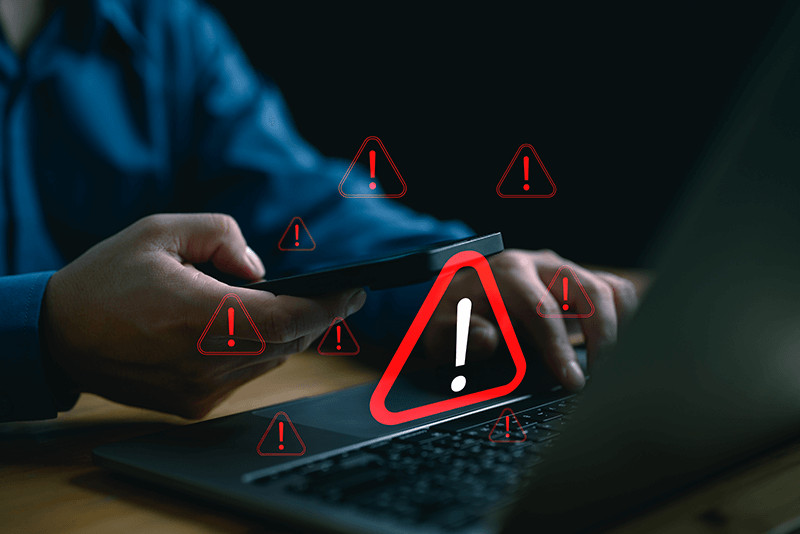
Multi-factor authentication (MFA) helps stop cybercriminals from accessing your private accounts by requiring a separate form of verification. While a helpful security measure, this tool still faces serious cybersecurity threats like MFA fatigue that put your sensitive information at risk. An MFA fatigue attack occurs when a cybercriminal already has your username and password and floods you with MFA requests for verification. Victims of this attack often approve one of the requests either to try to get them to stop or because they were tricked into doing so, inadvertently giving the cybercriminal access to their account. Learn how you can spot the signs of this cybersecurity threat and put measures in place to protect against it.
How Do These Attacks Happen?
An MFA fatigue attack begins even before you get the first request to verify a login attempt. First, the cybercriminal needs to obtain your login credentials. There are countless cybersecurity threats that specialize in stealing usernames and passwords such as phishing, brute force attacks, malware, and more. Luckily, there are also many ways you can protect yourself and your information from these cyberattacks. For more details, check out our blog: Easy Ways to Protect Against Cybersecurity Threats.
If a cybercriminal does manage to get a hold of your credentials but MFA is installed on your account, they may attempt to wear you down until you make a mistake. Multi-factor authentication works by sending a verification code to another form of contact you established when you created your account such as email, text, or app notification. In an MFA fatigue attack the cybercriminals relentlessly tries to log in, sending requests for verification to you over and over again.
Some cybercriminals will take it a step further and pose as a trusted figures or tech support, saying they are trying to access your account for a good reason. This could be disastrous for you and your business, even leading to cybercriminals holding your information hostage in exchange for a ransom.
How to Protect Against MFA Fatigue Attacks
Losing your or your business’ data to any cybersecurity threat is extremely stressful and devastating. MFA fatigue attacks can be particularly frustrating due to their repetitive nature and cybercriminals using a protection measure against their victims. The good news is there are multiple steps you can take to minimize the likelihood of a successful MFA fatigue attack.
Implement Stricter MFA Protocols
Multi-factor authentication fatigue attacks are effective cybersecurity threats because they exploit the weaknesses in relaxed MFA parameters. This is not set in stone though, and most MFA processes can be adjusted to include stricter security measures. For example, since MFA fatigue attacks work by sending multiple verification requests over and over again, you can adjust your program’s settings to limit the amount of time allowed between factor authentications. This effectively prevents cybercriminals from spamming you with verification requests.
It would also be beneficial to limit and record the number of unsuccessful logins attempts during a specific timeframe. This doesn’t just stop hackers from bombarding you with verification requests though. It also provides your IT team with an alert that an MFA fatigue attack is in progress so they can take the proper measures to prevent it.
Attend Cybersecurity Training
Protecting your business against cybersecurity threats like MFA fatigue attacks requires constant vigilance and training. Cybercriminals are finding new ways to steal your information every day. Cybersecurity training is a surefire way to prepare you for all the latest threats. Specifically, against MFA fatigue attacks, this training can teach you how to recognize the suspicious activity and report it to an IT professional. And for when cybercriminals pose as a trusted source to try to get you to accept their verification request, cybersecurity training can teach you how to spot these malicious actors and keep your data safe.
Increase Password Management
As mentioned earlier, MFA fatigue attacks are made possible because cybercriminals have stolen your account credentials. To minimize the risk of cybersecurity threats obtaining your password there are several measures you and your business can take. First of all, all of your passwords should be at least 12 characters with a mix of letters, numbers, and special characters. You should also avoid reusing passwords across accounts as this increases the chances of a cybercriminal stealing information from multiple platforms if they figure out that one login credential.
Strong passwords are important, but they aren’t enough. You also need to have strong password management in place to defend against all cybersecurity threats. Aside from MFA, using the Zero Trust approach is also key to keeping your information safe. This model requires the user attempting to login to verify their identity every time, no matter where they are located. No one is above suspicion, making it more difficult for hackers to break in.
Apply the Principle of Least Privilege
Another way you can keep your data secure is by limiting the number of people who have access to it, regardless of if their account has been compromised or not. This is known as the principle of least privilege. This approach restricts access rights for all users, allowing people to only view the information they need to accomplish their role in the business. This greatly minimizes the likelihood of a cybercriminal obtaining critical data after a successful cyberattack, as most people will not have access to this information.
Defend Against All Cybersecurity Threats with Strategy Tech Services!
Cybersecurity threats are constantly evolving to work around traditional security methods. The MFA fatigue attack does just that by utilizing verification messages against account holders, wearing them down until they unwittingly grant hackers’ access.
Looking for more helpful cybersecurity tips? Our free e-course has plenty of information on how to keep your cybersecurity strategies up to date and as strong as possible! Sign up for our cybersecurity e-course today and get started protecting all your information from cybercriminals.


